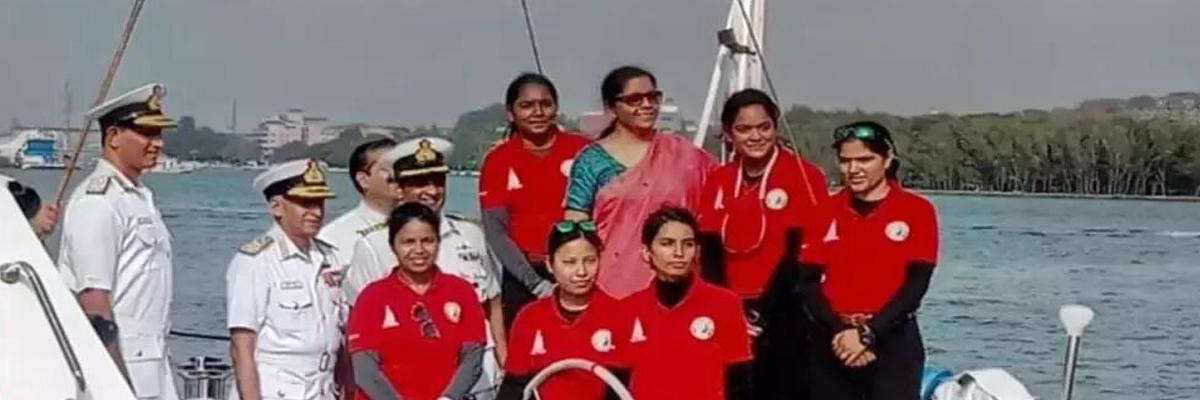Live
- Holi Festival: Liquor Outlets to Remain Closed for Holi in Hyderabad
- iQoo launches Neo 10R model
- Hyderabad: Woman Alleges Caste-Based Harassment by Roommates in Shaikpet
- Markets end on flat note
- Nifty Metal index falls after US tariffs
- AP minister clarifies on TIDCO houses, says all the issues will be addressed
- Uppal Stadium Preps for IPL with Rs 5 Crore Renovation
- Sebi speeds up rights issue process
- Ladhani Group to invest Rs 11K cr over 5 yrs
- Moody’s forecasts higher GDP growth in FY26

Gender inequality has been a social issue in India from the timeworn period Patriarchal imposts have depicted women in India as inferior to men, by which the births of girl children have been snubbed to a great extent It is high time that every child is treated equally and given equal opportunity to grow to their full potential
Gender inequality has been a social issue in India from the timeworn period. Patriarchal imposts have depicted women in India as inferior to men, by which the births of girl children have been snubbed to a great extent. It is high time that every child is treated equally and given equal opportunity to grow to their full potential.
It is in the cards that the women will be inducted as sailors in the Indian Navy in non-officer cadre, while India observes Navy Day on December 4. At a naval conference held on November 2, this convivial suggestion was made by Nirmala Sitharaman, the Defence Minister of India. The Chief of the Naval Staff, Sunil Lanba, has apparently accepted the proposal of inducting women in non-officer cadre.
The navy, however, is not the only service scouting the likelihood of inducting women in the non-officer cadre. The army has also been working on a similar plan. Nevertheless, the IAF is yet to consider recruiting women below the officer rank, though, in its first, the IAF has inducted the women as fighter pilots in 2015 only. There has been a long-debated question — whether women can be frontline combatants? Truly, a profession within the armed forces is encircled by so many difficulties.
Likewise, like any armed forces wings have distinct roles, the full range of operations undertaken by naval forces are immense. They range from high-intensity warfighting to disaster relief operations. But the women have proven that they can face any naval challenge.
For example, the Indian Naval Sailing Vessel (INSV) Tarini entered Goa harbour on completion of a historic global circumnavigation voyage on May 21. It was a poignant moment for the Navika Sagar Parikrama team comprising of an all-women crew, who began their voyage on September 10, 2017.
This voyage, unquestionably, has spotlighted the dynamic planning and execution capabilities of the women officers of Indian Navy. The women team members of INSV Tarini, during their voyage, had to face strong winds of more than 60 knots and very high waves of up to 7 metres. The success of this challenging voyage stretches an answer to what the women could do if deployed in combat roles.
By the same token, contrariwise, there are opinions that support a denial of combat roles to women. In her 1995 book Tailspin: Women at War in the Wake of Tailhook, Jean Zimmerman stated that there was a perception in the navy that women sailors use pregnancy to escape or avoid deployed ship duty. According to her, in 1993 the USS Cape Cod prepared to start out on a deployment cruise. Nevertheless, shortly before the scheduled departure, 25 female sailors informed being pregnant.
Also, a 1997 study by the Navy Personnel Research and Development Center (NPRDC) found that female sailors assigned to ships experienced higher pregnancy and abortion rates than shore-based female sailors. This turns out to be another reason why there is a tiny proportion of disapproval for the deployment of women sailors. Around the world, most of the women strongly believe that the military job should be considered like any other job, despite the fact that critics have voiced concerns about women being able to do the military job.
In India, the IAF in 2015 has taken an audacious step and inducted women as fighter pilots, which has been a successful mission. Also, the women sailors through Navika Sagar Parikrama have proven the power of women. Moreso, in modern electronic warfare, there is no traditional vanguard as such. In such a state, conceivably it is obligatory to allow women to have successful careers within the military for maintaining gender equality. Albeit surrounded by so many difficulties in the military jobs, many women still find that they thoroughly enjoy their jobs in the military while they serve the nation with zeal and dedication.
At this juncture, enrolling women in the non-officer cadre is definitely a warm move. Gradually, the armed forces are moving in the right direction —the triforces are utilising every possible opportunity to empower women. All those relevant policy changes undertaken by the armed forces affect the women who are dedicated enough to serve our nation. Every year, India observes Navy Day on December 4, to celebrate the achievements and contribution of the naval force to the country. This year, irrefutably, the raison d’ etre of celebrations will have the achievements of women as its focal point — not about gender; it is about their leadership, involvement, and revelation.

© 2025 Hyderabad Media House Limited/The Hans India. All rights reserved. Powered by hocalwire.com







